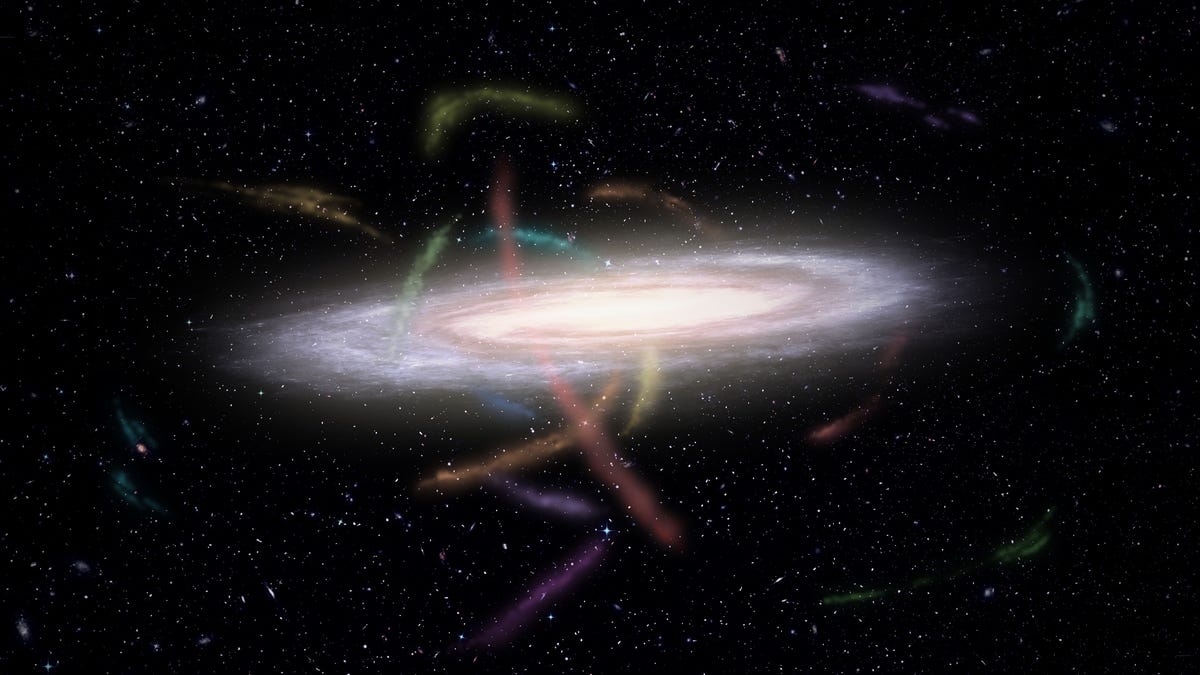Scientists find 12 shredded galaxies holding secrets of dark matter
A dozen stellar streams have entered the chat.

A depiction of stellar streams surrounding the Milky Way galaxy.
Studying dark matter is complicated. In reality, the best way to think about the phenomenon is as transparent matter. We can't seem to see it, and it doesn't interact with light, so essentially, it's invisible to us.
But scientists haven't backed down from the challenge. To date, they've come up with numerous unique ways to unveil the elusive stuff, as well as theories to explain it -- and in a paper published Tuesday in the Astrophysical Journal, a team of experts just added several new tools to the dark matter quest's arsenal.
They discovered a dozen never-before-seen stellar streams, or sparkly, pulverized remnants of ancient dwarf galaxies and star clusters orbiting the Milky Way. For eons, the Milky Way's gravitational pull has been disrupting such river-like structures' paths and eventually forcing them to merge with it.
In other words, our home galaxy has been feasting on its neighboring cosmic cul-de-sacs as though they're well-placed buffets. "As our galaxy is getting older, it is getting fatter," Ting Li, a professor at the University of Toronto and lead author of the paper, said in a statement. "This study gives us a snapshot of the Milky Way's feeding habits, such as what kinds of smaller stellar systems it 'eats.'"
So, where does dark matter tie in?
Well, stellar streams offer a roundabout way of deriving information of the universe's hidden building blocks by providing adjacent clues. For instance, astronomers can measure the streams' orbital speed, rotation trajectory, chemical composition and shape to see what isn't present.
"Think of a Christmas tree," Geraint Lewis, a professor at the University of Sydney and author of the paper, said in a statement. "On a dark night, we see the Christmas lights, but not the tree they are wrapped around. But the shape of the lights reveals the shape of the tree. It is the same with stellar streams -- their orbits reveal the dark matter."
The logic is fitting, as the only reason we even know dark matter and dark energy exists is due to a sort of indirect reasoning: According to scientists' calculations, all the universe's normal matter can't explain how most galaxies are held together and all the universe's normal energy can't account for its continuous expansion. We call the missing piece of the expansion puzzle dark energy, and of the structure puzzle, dark matter.
As per the team, the more stellar streams we can find, the closer we may be to understanding the nature of the universe's mysterious side. In fact, that's part of why Li and collaborators initiated a program called the Southern Stellar Stream Spectroscopic Survey to dedicate themselves to locating as many as possible. Along with data from the European Gaia mission -- which aims to chart an ambitious 3D map of our galaxy -- that's how the research team found the new, promising stellar streams.
Further down the line, Li said, stellar streams may prove critical in figuring out how the Milky Way came to be in the first place, after the Big Bang. "For me, this is one of the most intriguing questions, a question about our ultimate origins," Li said.

